
Kafr ʿInān, is a former Palestinian village, depopulated in the 1948 Arab–Israeli war. It was located around 33 kilometres (21 mi) east of Acre.

Kedesh was an ancient Canaanite and later Israelite settlement in Upper Galilee, mentioned several times in the Hebrew Bible. Its remains are located in Tel Kedesh, 3 km northeast of the modern Kibbutz Malkiya in Israel on the Israeli-Lebanese border.

Hamaam, or Wadi Hamam, is an Arab village in northern Israel, located near the Sea of Galilee, at the foot of Mount Nitai and across the Wadi Hamam valley from Mount Arbel. It is the easternmost part of the al-Batuf Regional Council. In 2022 its population was 1,561.

The Upper Galilee is a geographical region located in northern Israel and southern Lebanon. Part of the larger Galilee region, it is characterized by its higher elevations and mountainous terrain. The term "Upper Galilee" is ancient, and has been in use since the end of the Second Temple period. From a political perspective, the Upper Galilee is situated within the administrative boundaries of the Northern District of Israel.
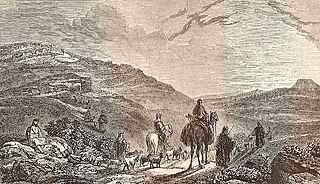
Teqoa is a Palestinian town in the Bethlehem Governorate, located 12 km (7.5 mi) southeast of Bethlehem in the West Bank. The town is built adjacent to the biblical site of Tekoa, now Khirbet Tuqu', from which it takes its name. Today's town includes three other localities: Khirbet ad-Deir, al-Halkoom, and Khirbet Teqoa. According to the Palestinian Central Bureau of Statistics (PCBS), Teqoa had a population of 8,767 in 2017.
Khirbet Kerak or Beth Yerah is a tell located on the southern shore of the Sea of Galilee in modern-day Israel. The tell spans an area of over 50 acres—one of the largest in the Levant—and contains remains dating from the Early Bronze Age and from the Persian period through to the Early Islamic period.

Jish, also known by its Hebrew name of Gush Halab, or by its classical name of Gischala, is a local council in Upper Galilee, located on the northeastern slopes of Mount Meron, 13 kilometres (8.1 mi) north of Safed, in Israel's Northern District. In 2022, it had a population of 3,216, which is predominantly Maronite Catholic and Melkite Greek Catholic Christians (63%), with a Sunni Muslim Arab minority.
Susya is a location in the southern Hebron Governorate in the West Bank. It houses an archaeological site with extensive remains from the Second Temple and Byzantine periods, including the ruins of an archeologically notable synagogue, repurposed as a mosque after the Muslim conquest of Palestine in the 7th century. A Palestinian village named Susya was established near the site in the 1830s. The village lands extended over 300 hectares under multiple private Palestinian ownership, and the Palestinians on the site are said to exemplify a southern Hebron cave-dwelling culture present in the area since the early 19th century whose transhumant practices involved seasonal dwellings in the area's caves and ruins of Susya.

Meiron was a Palestinian village, located 5 kilometers (3.1 mi) west of Safad. Associated with the ancient Canaanite city of Merom, excavations at the site have found extensive remains from the Hellenistic and Early Roman periods. The remains include a 3rd-century synagogue, and Meiron served as a prominent local religious centre at the time.

The Nabratein synagogue or Navoraya synagogue is a former ancient synagogue and archaeological site, located in a pine forest northeast of Safed, in the Upper Galilee region of the Northern District of Israel.
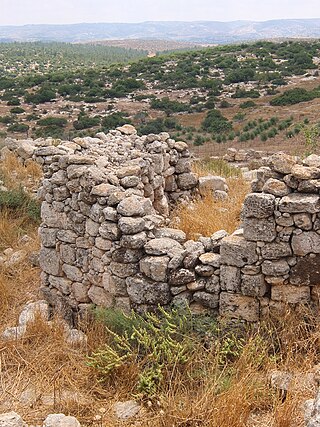
Khirbat Umm Burj was a Palestinian Arab village in the Hebron Subdistrict, sometimes designated in modern maps as Burgin. Its ruins are today located within the borders of Israel. It occupied an extensive site, stretching about 30 dunams on the crest of a hill, rising some 430 metres (1,410 ft) above sea level, and commanding a good prospect of the surrounding region. It was depopulated during the 1948 Arab–Israeli War on October 28, 1948, during the third stage of Operation Yo'av under the command of Yigal Allon. The site is located 17 km northwest of Hebron.

Chorazin or Korazim was an ancient village in the Roman and Byzantine periods, best known from the Christian Gospels. It stood on the Korazim Plateau in the Upper Galilee on a hill above the northern shore of the Sea of Galilee, 2.5 mi (4.0 km) from Capernaum in what is now the territory of modern Israel.
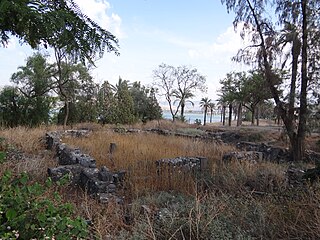
Al-Sinnabra or Sinn en-Nabra, is the Arabic place name for a historic site on the southern shore of the Sea of Galilee in modern-day Israel. The ancient site lay on a spur from the hills that close the southern end of the Sea of Galilee, next to which towards its south being the tell, Khirbet Kerak or Bet Yerah, one of the largest in the Levant, spanning an area of over 50 acres. Bet Yerah was the Hellenistic era twin city of Sennabris, as al-Sinnabra was known in Classical antiquity, and its remains are located at the same tell.

Ancient synagogues in Israel refers to synagogues located in Israel built by communities of Jews and Samaritans from antiquity to the Early Islamic period.
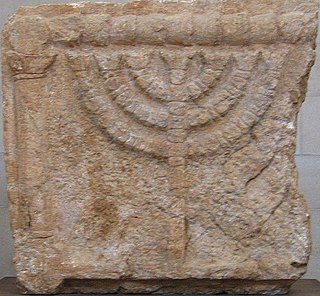
Ancient synagogues in Palestine refers to synagogues and their remains in the Land of Israel/Palestine region, built by the Jewish and Samaritan communities from the time of the Hasmonean dynasty during the Late Hellenistic period, to the Late Byzantine period.
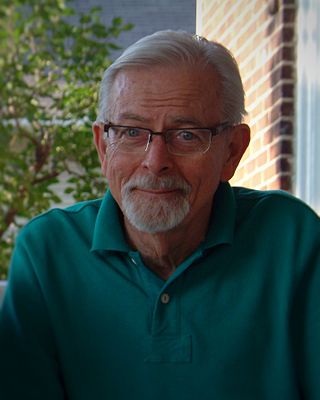
Alf Thomas Kraabel was an American classics scholar and educator who worked extensively in Greek and Hellenistic Judaic studies. He served as a faculty member in the classics department at the University of Minnesota from 1963 to 1983, and served as the Dean of Luther College in Iowa before retiring in 2000.

Bersabe, also known as Beersheba of Galilee, was a Second Temple period Jewish village located near the town of Kefar Hananya which marked the boundary between the Upper Galilee and the Lower Galilee, as described by Josephus, with Upper Galilee stretching from Bersabe in the Beit HaKerem Valley to Baca (Peki'in) in the north. Bersabe was one of several towns and villages of Galilee fortified by Josephus during the First Jewish–Roman War, being one of the most defensible positions and where insurgents from across Galilee had taken up refuge against the Imperial Roman army when the surrounding countryside was plundered.
The Book of Joshua lists almost 400 ancient Levantine city names which refer to over 300 distinct locations in Israel, the West Bank, Jordan, Lebanon and Syria. Each of those cities, with minor exceptions is placed in one of the 12 regions, according to the tribes of Israel and in most cases additional details like neighbouring towns or geographical landmarks are provided. It has been serving as one of the primary sources for identifying and locating a number of Middle Bronze to Iron Age Levantine cities mentioned in ancient Egyptian and Canaanite documents, most notably in the Amarna correspondence.
Jarmaq was a village in the northern Galilee, near Safed. It was inhabited by Druze before it was abandoned in the 1880s.


















